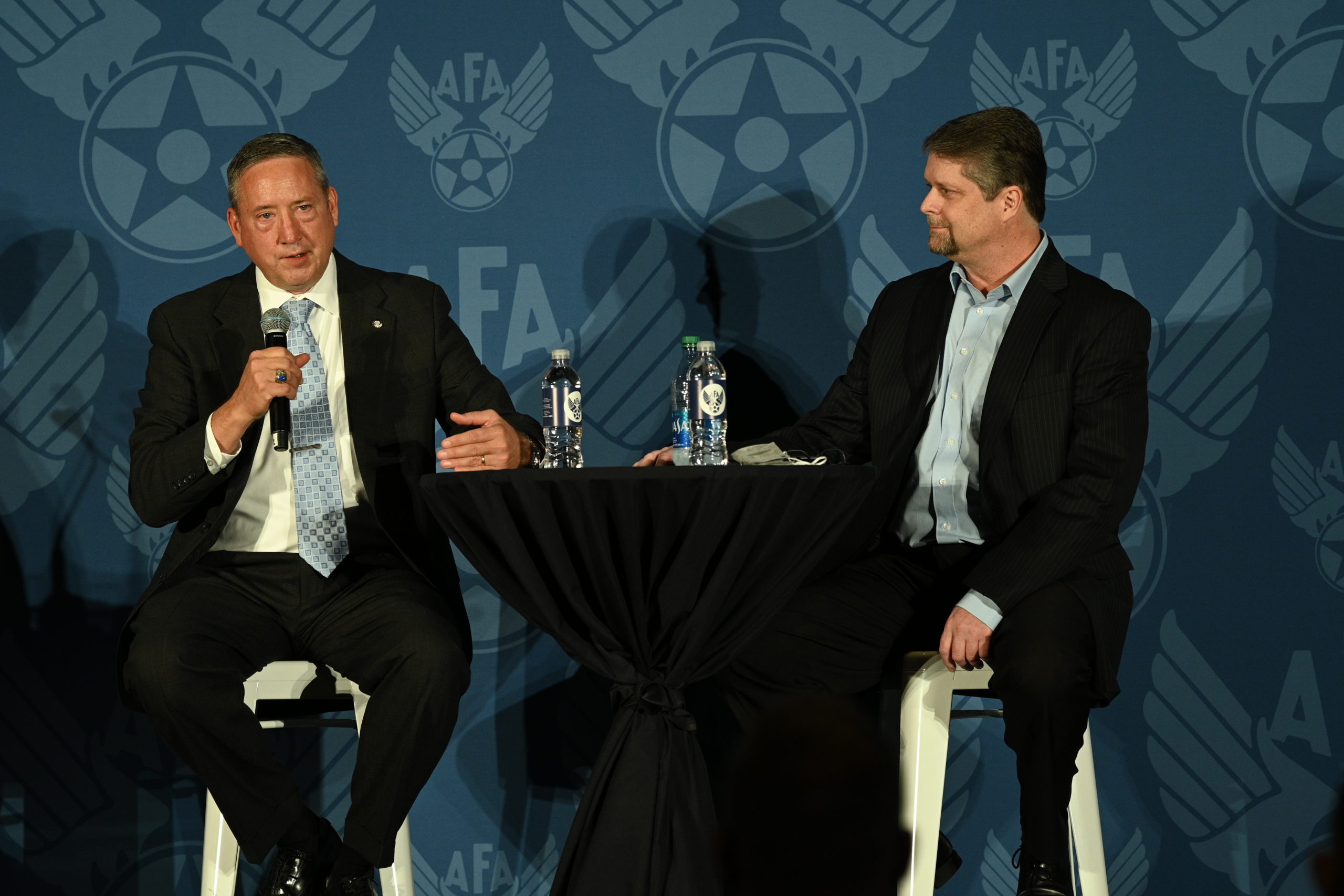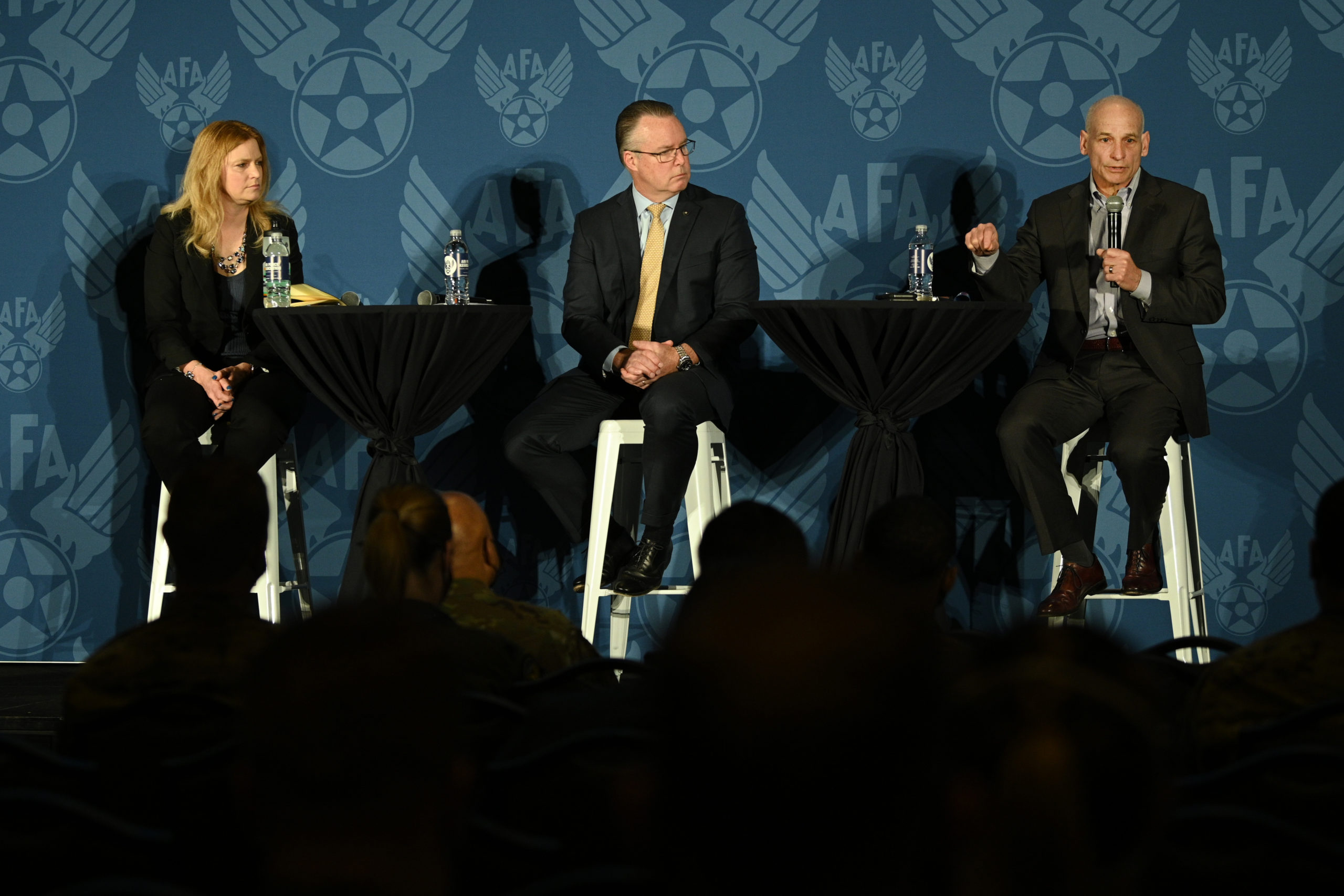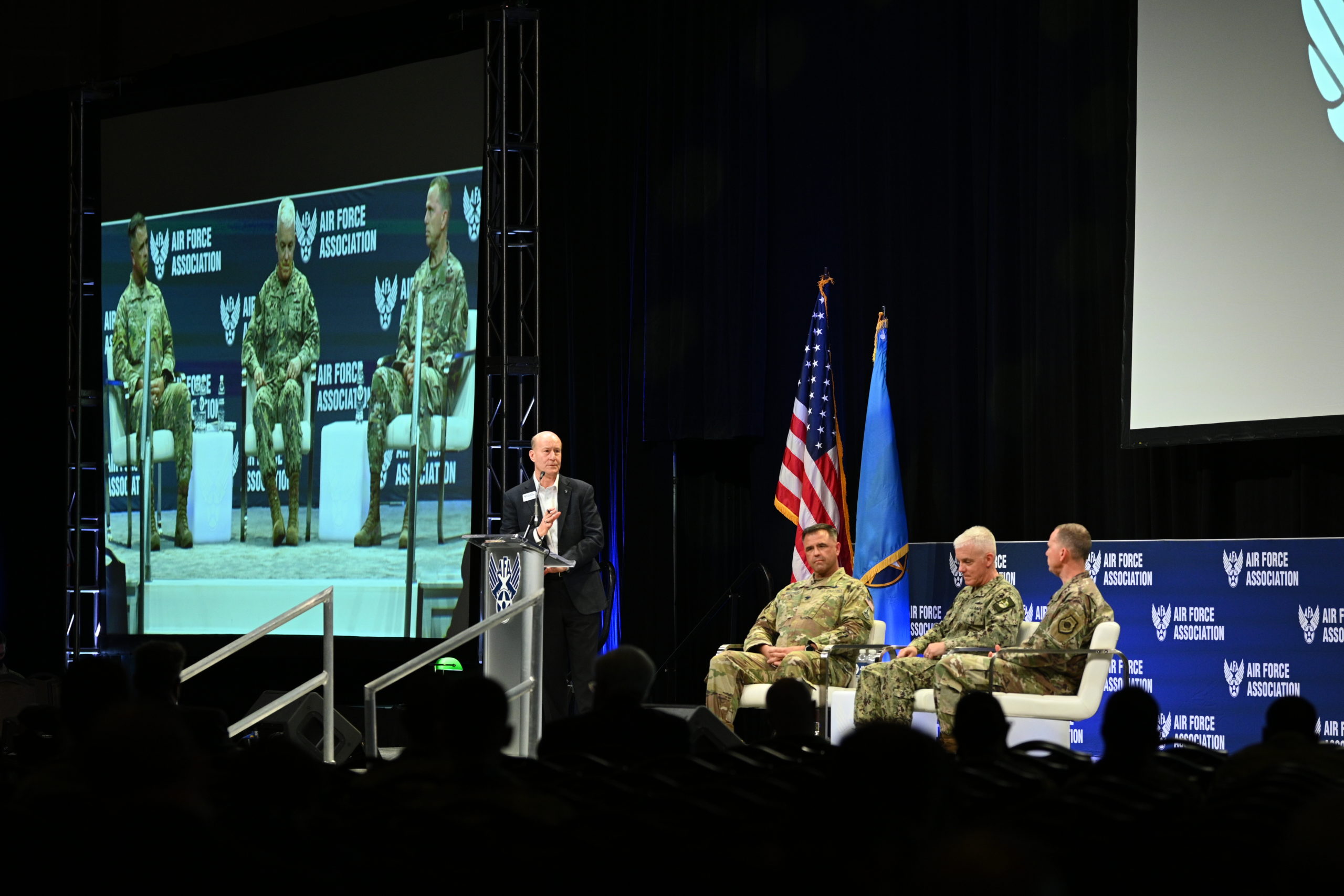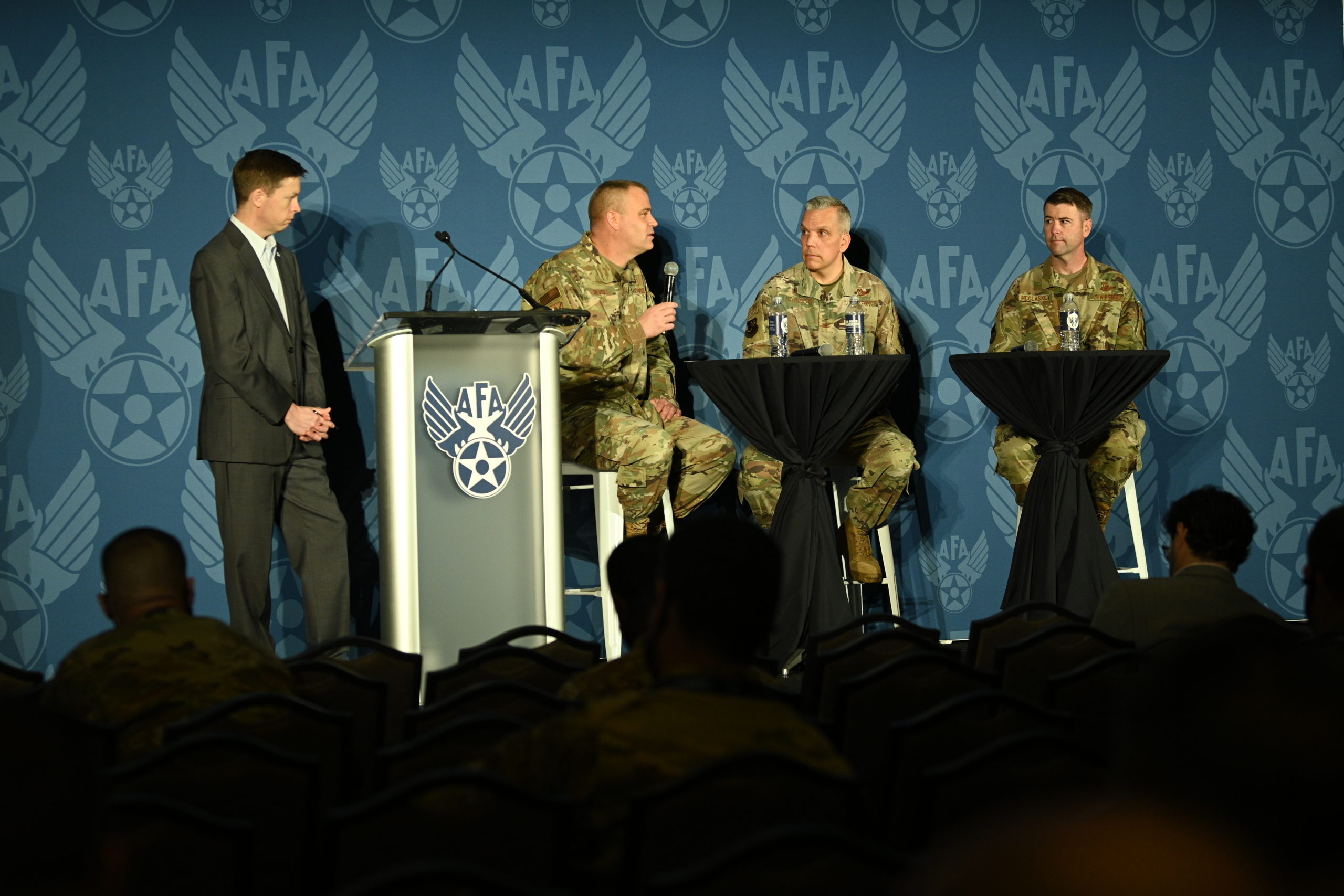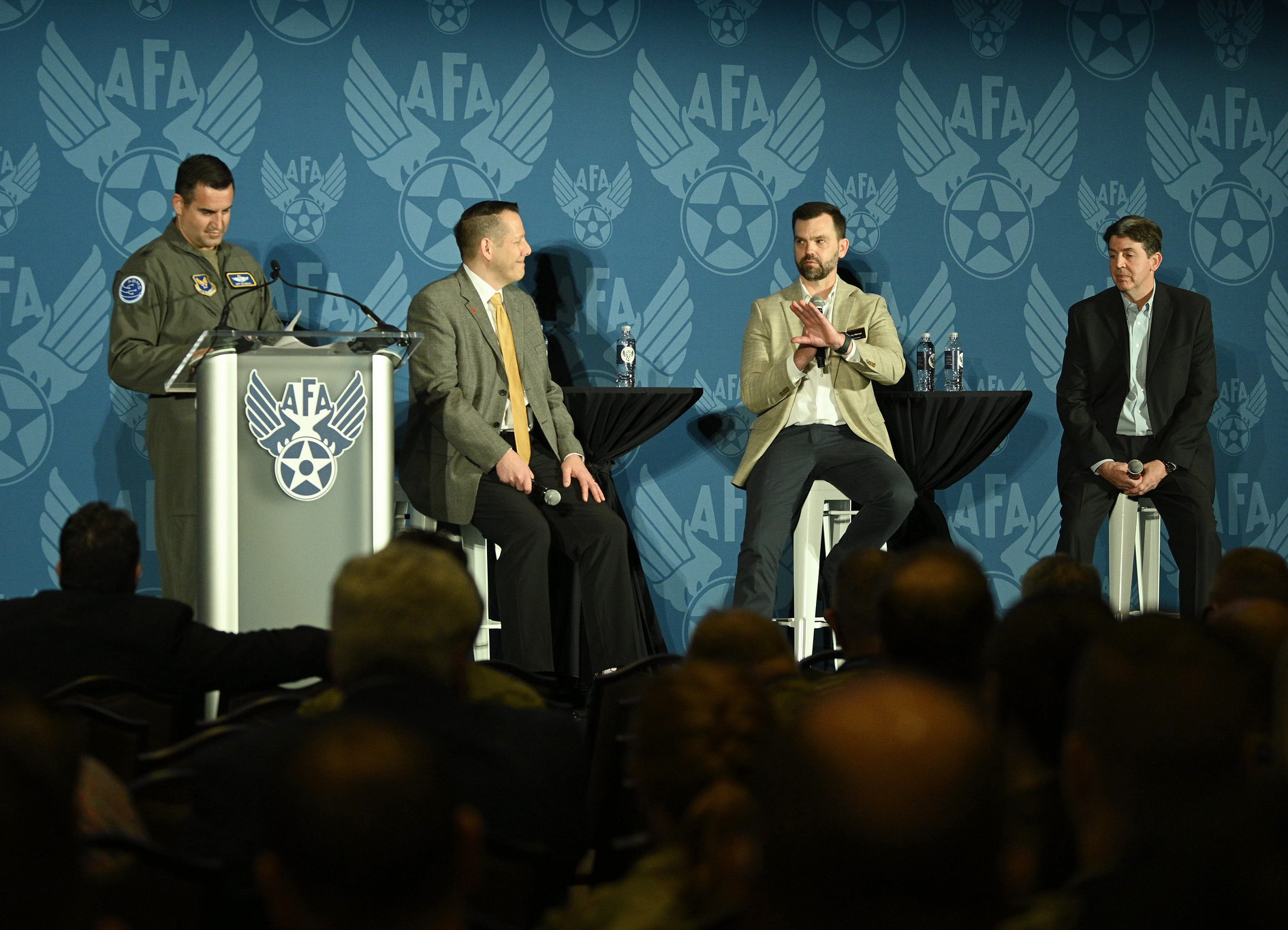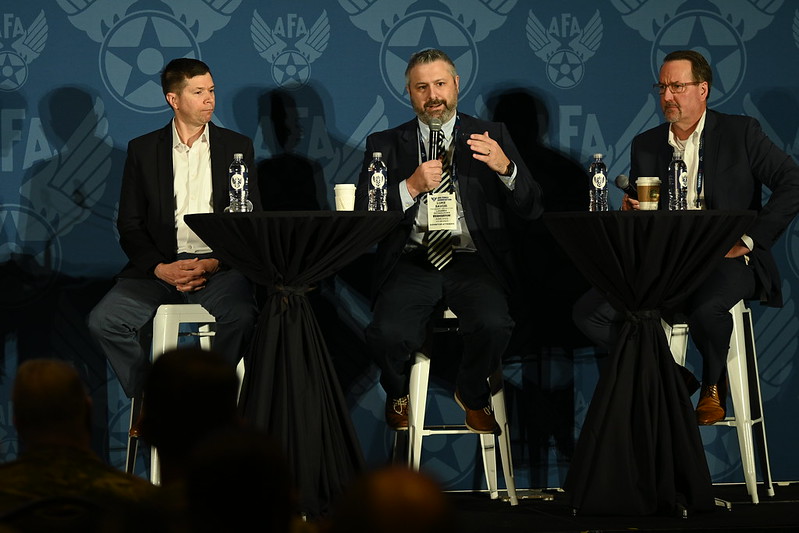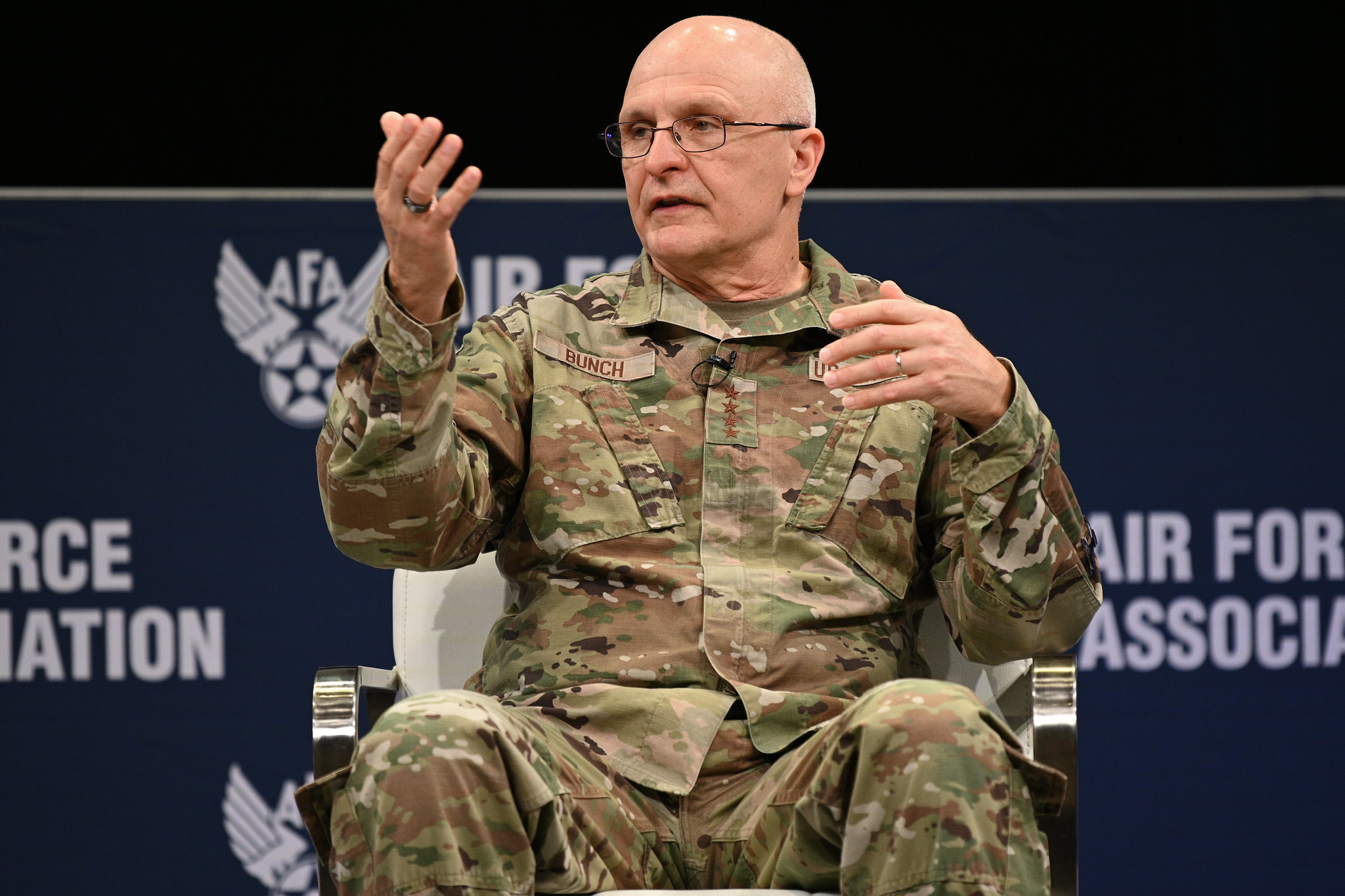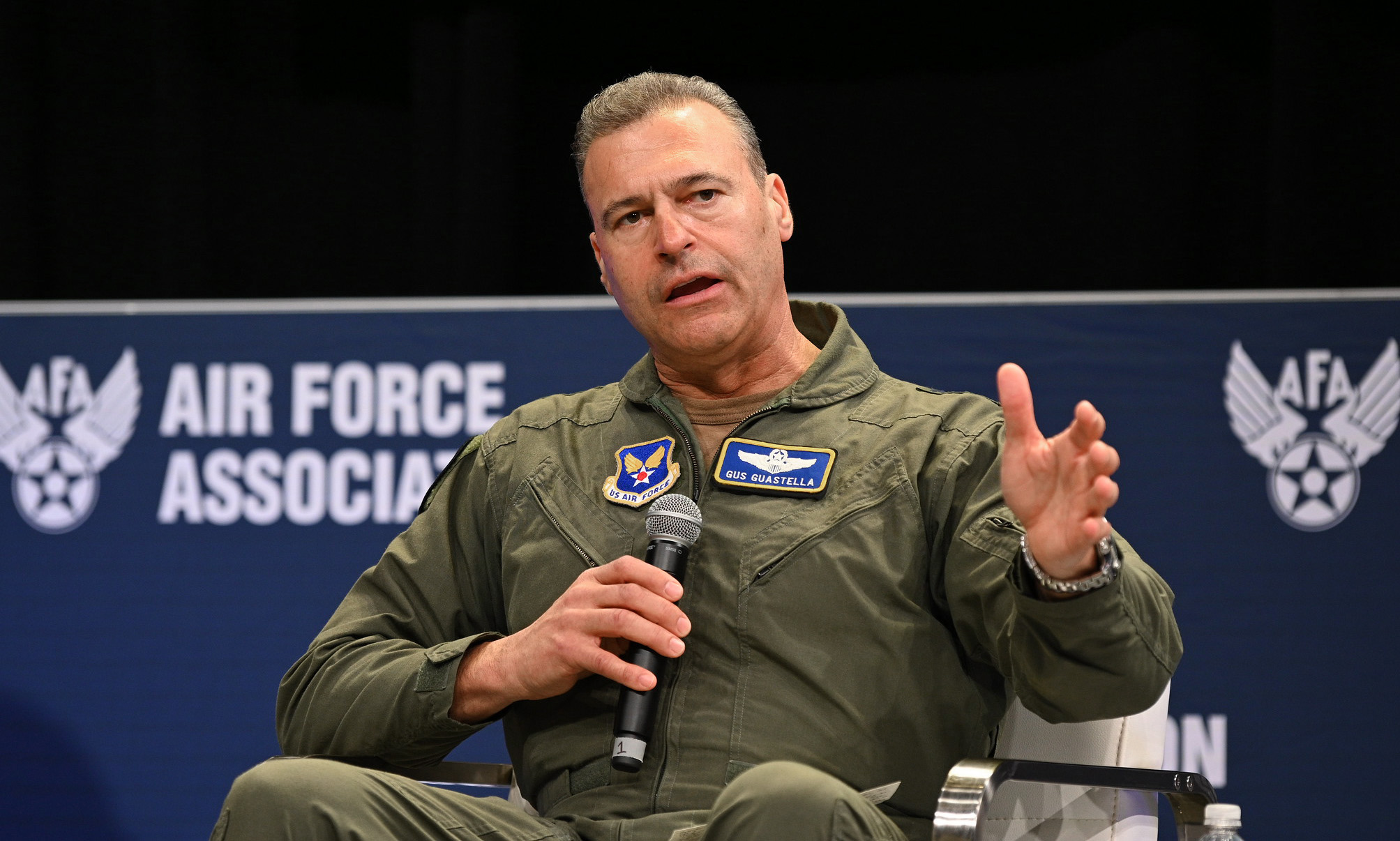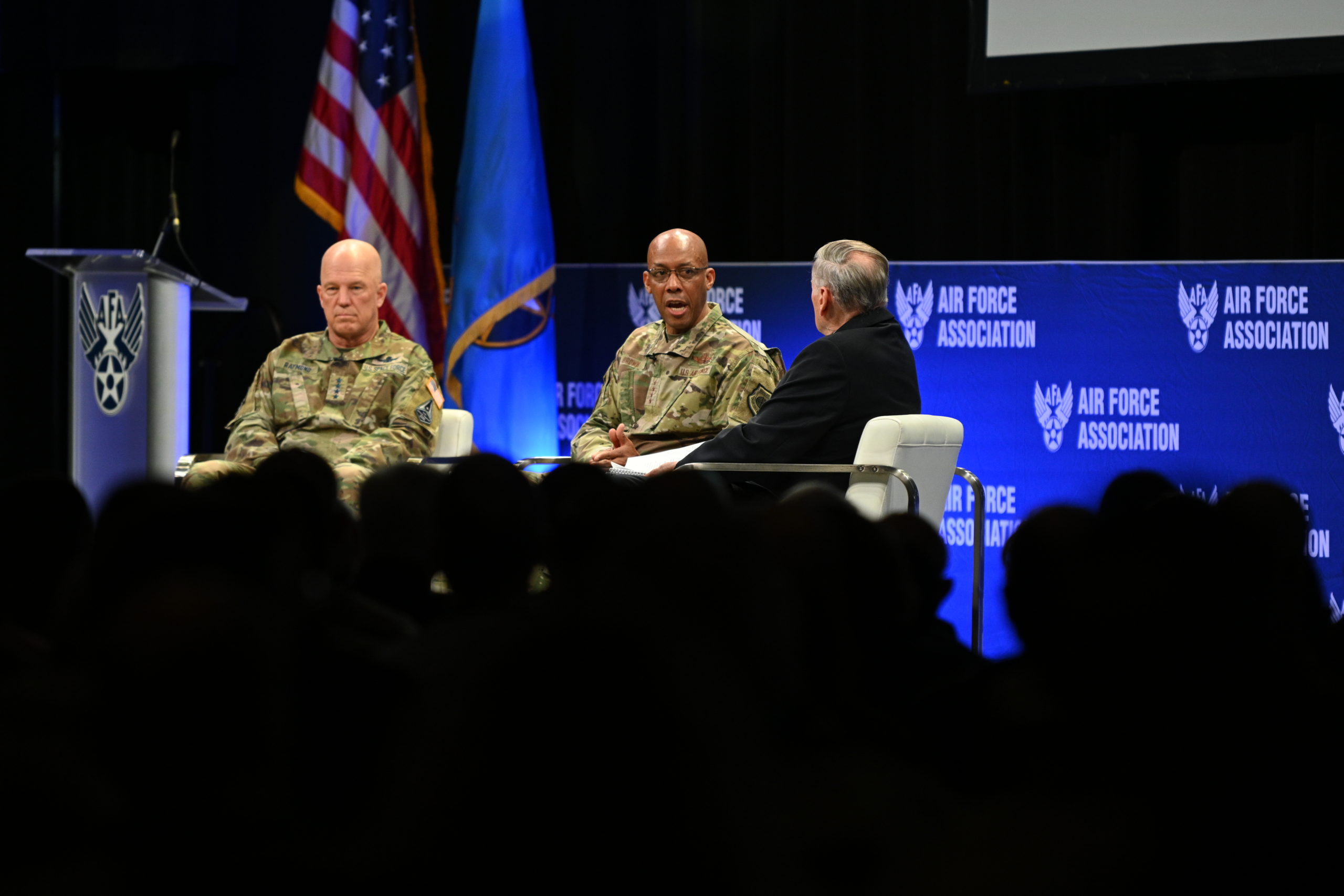Maj. Gen. David A. Harris, director of integration and innovation for the Deputy Chief of Staff for Strategy, Integration and Requirements, moderates a discussion with retired Maj. Gen. Jon Norman, vice president of air power requirements and capabilities for Raytheon Technologies, and Garret Johnson, precision guidance and sensing systems technology director for BAE Systems titled “Air and Missile Defense” during the AFA Warfare Symposium on March 4, 2022. Watch the video or read the transcript below. This transcript is made possible through the sponsorship of JobsOhio.
Maj. Gen. David A. Harris, director of integration and innovation for the Deputy Chief of Staff for Strategy, Integration and Requirements: Ladies and gentlemen, good morning. My name is Major General Dave Harris, I work in the Air Force A5, Futures, which is strategy, requirements and integration. This morning, we are honored to have two incredible reps with us today to talk about integrated air and missile defense. First, we have Maj. Gen. Jon Norman, US Air Force Retired, Vice President of Air Power Requirements and Capability at Raytheon. We also have Garret Johnson, Director of Precision Guidance, Sensing Systems and Technology. How about a big round of applause for our panelists? So let me start just by turning it over to both of you, gentlemen, for a few opening remarks. Gen. Norman.
Retired Maj. Gen. Jon Norman, vice president of air power requirements and capabilities for Raytheon Technologies: OK, I’ll start up first. First off, I want to say thank you to Orville Wright and the entire AFA team for putting on this event for us. It’s so nice to do this in person, and not look at the Hollywood Squares of Zoom. It’s worth its weight in gold. Certainly these events like this, all the engagements that we can do in between the events and then certainly down the floor. So thank you again to the AFA. And thanks for the Air Force for breaking free all of our, our general officers and our airmen so that we can do that direct interaction that we need from industry.
This topic is incredibly relevant. I look at what our peer adversaries, so both Russia and China, have done and their investment in long-range defensive capabilities. So you look at the S-400, the S-500. The effect that A2AD environment can impose upon us as a US warfighter and our coalition partners, and you sit there and scratch your head. We’re Americans, I firmly believe that we can make a SAM that goes far beyond the range of Patriot and THAAD. And we should look. I look the cost that’s been imposed upon our forces by the A2AD environment that our adversaries have placed in different parts of the globe. And I think that would give us a significant advantage. We can impose costs on the Russians, we could impose costs on the Chinese, not give them that freedom of movement, freedom of action. And more importantly, it frees up our resources from doing these DCA/CAPs for that air threat to now doing offensive ops.
On the defensive side, we have an adversary has been watching us at war for 20-plus years, they see how we work our C2. They see how we do our TTPs and they see how we’re organized trained and equipped and how we work as a joint force and coalition force. It gives them a significant advantage over us not seeing them in action. They’re able to design offensive weapon systems that can then hold those key command and control centers and our key force projection capabilities at risk. As you look at the nature of warfare, it’s really an evolution in what they’re doing. So what went from aircraft in the past to ballistic missiles, to now hypersonics that travel up in the ionosphere just above where our historical defenses have been, or our historical sensors have been, and to maneuvering in terminal where it complicates our targeting ability with our current defenses. So certainly the Defense Department’s been taking notice, and we across industry have been working very closely both with the services and with MDA to come up with counters to that, you know, the Navy’s SM-6, phenomenal capability. The work that MDA and the services are doing with the ground phase interceptor, very incredible capability. I think what we’re seeing is a transition to defense in-depth. Instead of everything being that terminal “glove save” capability where you’re hitting the incoming threats just prior to impact. We’re pushing that further and further out during or throughout the threat envelope.
And so now you’re able to sense and target these threats while they’re in mid-course guidance. Ideally, you’d hit on that boost phase intercept. The challenge with all the investment that we’re doing in this defensive capability, and you know, it’s going through weapons school, and I look at defensive strategies as loser strategies. You have to have them, but it doesn’t compel a change in threat behavior. So it’s a force protection, right, requirement, we have to have that for our forces to operate and to impose a threat upon the enemy so you can compel a change in behavior.
From a deterrence standpoint, you have to have that defensive capability so that they understand that they don’t have freedom of action. But you also have to have a … very real and very credible offensive capability. I look at our investment in this hopefully an investment in in a longer, much longer range surface to air missile capability as a force multiplier for the U.S. Air Force, because it frees up all those assets we previously had doing defensive operations for offensive. I think the service has been doing the right thing as you look at both what Gen. Wilsbach and Gen. Harrigian are doing for PACAF and for USAFE, and pushing the envelope on air-based air defense. We’re seeing that through our Air Force Research Laboratory through the [inaudible] program. They’re doing a bunch of experimentations. And then we’re certainly seeing it through NORAD and NORTHCOM for homeland defense. It’s a critical requirement, we have to be able to protect our forces at our bases of operations. And the threat is a huge spectrum: anything from, you know, a enemy combatant trying to penetrate our outside wire, we’ve seen that in Afghanistan, to mortar shells coming in, to drone attacks—a very low cost drone flying over the wire and dropping an explosive device near one of our aircraft has just as much impact as a potentially as a ballistic missile coming in—to defense against cruise missiles and defense against aircraft. And so it’s a spectrum. But it’s that terminal defense that right now we’re seeing the gap. So I know the Air Force has engaged heavily with the Army and within OSD, looking at roles and missions. But while that’s going on, we can’t afford to have our forces at risk. So I’m happy that the Air Force is pursuing that. And I think across industry, we’re fully in support of it. And I think, strap in and watch how this unfolds.
Harris: Those are great comments. And I think we’re gonna have questions just following on with that. So looking forward to getting into the Q&A here shortly. Garret, over to you for a few open comments, please.
Garret Johnson, precision guidance and sensing systems technology director for BAE Systems: Thank you. Yes. My name is Garret Johnson, I’m honored to be given the opportunity to speak here today. Let me tell you a little bit about myself. I am currently the Precision Guidance Sensing Solutions director for BAE. Prior to that I worked with the Missile Defense Agency advanced technologies, extending the next-generation system. Before that, I actually worked for Raytheon helping out on their missile defense applications.
So my background is I’m an engineer, my subject matter expertise is guidance, navigation controls and precision point applications. So when I think of this problem space, when I think of the next emerging threats that the air and missile defense systems have to accommodate, when I put it into the context of a peer threat engagement and extended peer threat engagement, and conceptualize the quantity of aimpoints that we have to be able to service, one of the themes that I think is critical for us to address and look forward to is the ability to identify a capability spectrum that allows us to put the right energy on the right target at a competitive price. And so when we think of how do we handle the next-generation threats, how do we engage the near peer threats, that’s an aspect of the equation that we need to factor in. We will need to really be able to focus and achieve the quantity required to be able to surface those large quantity of aimpoints. So I look forward to the discussion. Thank you.
Harris: Very good. And I think the piece on the cost and position in the emerging tech is something we’re going to pull the thread on here in a little bit. But Gen. Norman, over to you first. As we go through a lot of the wargames, I know that we’ve seen the need to power project is so critical early, and then be able to mass effects on one area, then disaggregate. And what complicates that, quite frankly, is the air and missile defense systems of the adversary. One thing that we found that was really compelling is this air weapons layer. So when we talk about air-to-air munitions, and what they can do today, but how we can make them complementary to this problem set. What are your thoughts?
Norman: I appreciate that, you know, it’s pretty easy to be pejorative on legacy, whether it’s platforms or weapons. I think it’s important that we understand that through the [inaudible] investment that the services do, and that we work with our partners, the capability is vastly different.
We talked about this before in previous AFAs. But, you know, a 1958 Corvette is fundamentally different from a 2022 Corvette. Still has the same name, but it’s fundamentally different. I look at the advancements that through MDA and through the Army that we’ve done with the Patriot system. Fundamentally different capability than when that system was fielded, still called the Patriot. From our aspect of Raytheon, so we make we make the AMRAAM. So the AMRAAM that we’re building today, on the D-3, so you’ll often hear it referred to as F3R, form, function, fit, replacement, the entire stack is different. Within that missile, the missile capability is fundamentally different. Its ability to address defenses, from DRFM jammers, Level Five and beyond, is fundamentally different. We’re changing the way that we run the flight control computer within that missile, so that we’re able to see much further ranges out of that same missile still called an AMRAAM.
And we’re working with our partners, Kongsberg and Nammo to develop an improved back-end rocket motor. And that’s getting integrated into the NASAM system. So that we can give a range beyond where Hawk is, from a surface-launched AMRAAM. And that same system, we’re integrating AIM-9X so that you ca,n you can increase the capacity against a wide variety of targets sets. I think across industry, we’re working on both directed energy and laser weapons.
Garret, to specifically address what you talk to there, you have to have magazine depth. You know, the Air Force is looking at Agile Combat Employment. So it’s history repeating itself. You know, we used to disperse forces all the time. Why? Because the threat demanded that. We’re seeing that threat reemerge that’s demanding that. So we can’t consolidate all of our forces into a single location because it greatly simplifies an adversary’s investment requirement. Let’s hit that single point and overwhelm any defenses that they have. So it started out actually in PACAF, we’re doing Rapid Raptor. So the concept of taking the F-22 with a tanker, a contingent of maintainers and munitions, and rapidly deploying throughout the Pacific theater. That’s evolved into what we’re doing today with Agile Combat Employment. So Gen. Guillot over in AFCENT is working that, certainly Gen. Harrigian is working that in USAFE, and then Gen. Wilsbach is working the same concept unique to their specific theaters in the Pacific theater.
So then we complicate an enemy’s ability to hold our forces at risk. As we continue down this path, you talked about this, we’ve certainly heard it from Secretary Kendall, we have a finite budget, we’re under a CR right now and that the CR expires at the end of next week. They’re working on the ’23 POM, hopefully they’ll be released very soon, out of The Hill. But we’re in a constrained budget environment. It’s a zero sum game. So every dollar we invest, we’ve got to squeeze the most capability out of, out of that investment. And so for the near term, we have to look at where the threat has created gaps. What can we do with our existing platforms and weapons through PQ-DI, and then very smartly invest in that next incremental growth? I think across industry, what we’re seeing is the investment, our technology investment in modular open system architectures, and weapon open system architectures, so that everything we develop can be rapidly integrated into the platforms or the systems, we’ve got to do that.
And what we do in PQ-DI today, we should use that as a building block. Ideally, as we’re looking at that mid and long term investment, we should make a family of weapon systems that can be rapidly upgraded, so we can scale them up or down to add that capability. And then we just change propulsion to affect that attribute of range or speed. So I think there’s a lot of opportunity there. We certainly have a lot of capability in the near term, through PQ-DI to improve and modernize our existing platforms and weapons. And I appreciate the direction the Air Force has gone through OI and our engagement with the Requirements Directorate in the Air Force so that we’re investing every dollar of limited IRAD that we have against their priorities. Thank you.
Harris: And I think the speed in which we get after that that change and how fast we can keep pace is also going to be important. And I think that’s a great partnership between the military and industry on this one. But I love your analogy about the Corvette, that the Corvette of the old, or today is not the same as the Corvette of yesterday. So I’m going to go over to Garret real quick and just say that you know that this speaks to me of emerging technologies. And we talked about the Corvette of today, the first thing that comes to my mind is hypersonics. Can you give me your thoughts on what we see right now as far as technologies available, and what can we do to be able to either counter that hypersonic threat, or challenge that in the air and missile defense domain?
Johnson: Oh, it’s a great question, actually. And it’s a challenging new threat that we have to address.
So if you’re going to look at this, what my recommendation would be is to understand clearly the distinctions between those two main classes, the cruise, hypersonic, the boosting glide, probably the most challenging out of those. But understand that each one of those individuals is a product of a kill chain. Understanding how to attack that kill chain, the ability to confuse, disorient, deny, those are technologies capabilities that we have that will come into play.
If you look at using both the kinetic and non-kinetic aspects to address these threats, and the combination of those in something that I would call cooperative engagement, but that’s another key. In each one of these weapon systems there is a trajectory. In the boost glide scenario, there’s the boost, the mid course, and the terminal phase. Looking at each one of those individually, identifying those sensitivities, and applying them is going to be key. If I look at the kinetic piece of it, and I focus in on, say, the, boost glide element of it, there’s really a spectrum of solutions that be brought to bear for this. On one end of that spectrum, it’s the kind of the air-to-air philosophy of, if I’ve got a threat, it’s got a certain capability, a certain maneuverability. What I want to be able to do is, I want a maneuver factor above that. I want to be able to use that factor to sense respond and engage. And so that really, in the context of a new weapon that is being defended against, causes you to go down a path of developing a comparable asset, and then enhancing that capability to be able to go toe to toe.
So that’s one end of the spectrum. The other end of the spectrum is the call of the overmatch situation, where you fundamentally have a set of capable weapons, but they don’t have the same capability of the threat that you’re going against. So the ability to use a set of weapons in a cooperative engagement, for lack of a better term, to partition the scope of that solution, to have the M act as one, the many act as one. So on an M-on-one type engagement, that’s the other end of the spectrum. And when I look at that side of the spectrum, what I end up seeing is that that’s an opportunity, open door, actually, to take some legacy products that have inherent capability, add some technology to it, incorporate a different conops relative to how you engage, look at it as the ability to allow the weapons themselves to make certain decisions at speeds that are not able to be done when we have a direct human in the loop.
At the same time though, what you’re going to want to be able to do is to assure the warfighter that they have control of the outcome. And so when I think of this, what can you basically do for this emerging threat? It’s really a spectrum of answers here. It’s the kinetic and non-kinetic, the combination of this, it’s the ability to look at the problem a little bit new, to be perfectly frank. Thank you.
Harris: So at Air Force Futures, we do a lot of thinking about long-range kill chain and looking at these mission engineering threads is what we’ll call it. And a lot of times it’s capability that we have today that might not be perfectly suited against an adversary to have that equal matchup, but there’s some gaps in it. With just some minor modifications, we can make some tweaks, and those are the concepts that we try to develop, and then we test them out through wargames. So General Norman, I’ll go back to you with what we’re seeing rise globally, and the importance, really, of base defense. You said before we’re going back to the future with ACE. How important is, or how can we better address these concepts, to defeat the integrated air and missile defense systems by employing different concepts and and getting after the enemy in a different way?
Norman: I appreciate that question. I think first and foremost through the future games that your team runs. So it gives industry, through our model-based system engineering, to bring—whether it’s a sensor or an effector—into a war game that the service is running against a future threat, to see where we get the most value for our investment, to see where we can modify our TTPs. So we can add incremental capability to our existing legacy effectors and sensors. And where those gaps still exist, so that both the service understands where that investment’s required, and then certainly from the industry side, where we need to invest our very limited IRAD money to help accelerate that delivery.
When you look at the air base air defense, I love how open our Air Force leadership is. I think across industry, we have very, very good access to both the folks that are that are making all the decision briefs, as well as our decision makers. And when you talk with some of the major command commanders or our combatant commanders, you find a pretty consistent theme. So there’s an appreciation for how much sensing capability that we have, whether it’s from commercial networks, commercial sensing, space, as well as our tactical and theater level sensors.
The challenge is how do you pull all that information together, do the correlation and fusion to develop a common operational picture. And I think that’s what the A5 is really taking on with this JADC2 and ABMS, and then the other services, through Project Overmatch and Project Convergence. Vital that we get this right and get it out fast. I would suggest that we have got to have a layer in our, in our sensing capability, so at extreme range. So that we’re able to provide that defense in depth to allow the fires to engage at midcourse against these hypersonic threats, engage the ballistic missiles as they’re coming down from apogee, engage the cruise missiles as they’re flying in low, perhaps popping up. And then certainly any type of swarming activity, whether it’s from aircraft or uncrewed vehicles, I’ll listen to the SecAF.
We’ve got to be able to do that. So we have a system called the Early Warning Radar. [Inaudible] Well, it’s working today. It’s in operation 24/7. Globally, we’re fielding this. It’s been modernized the entire time, and is able to look at an advanced threat. Lockheed is investing heavily through requirements direction from MDA on LRDR, which gives us an S-Band. We have Space Fence, which gives us a look up in the LEO. This isn’t just from air, it’s also from space. So as we bring that threat in to our dispersed forces, that we’re working on their ACE, we’ve got to be able to defend not just from our existing locations before we disperse our forces, but from those new locations. And so it’s picking that right capability. So what sensor do I need to have an operational picture around this, this ACE-located operating location? And my main base operating area? And then what effectors do I need?
The challenge I think that the Air Force has with this is that close-in threat, it typically tends to overwhelm the defenses. So I think that there’ll be a big need for non-kinetic, whether that’s laser or microwave. I could see also a big need for the kinetic to defend against the cruise missiles as well as the aircraft that are coming in that were able to get through the fences. I see our biggest need as an investment as a nation and its roles and missions for the Air Force and Army to work together to drive consistent messaging for the need for that new air defense surface-to-air missile that drives out our A2AD. So we’re able to give that defense in depth and everything isn’t final. All this, it’s a state, it’s a requirement, we have to have this to operate. And then that allows the Air Force to free up resources so that we can do the offensive capability. So we can actually compel a change in behavior from our adversaries.
Harris: Good points and I think these new munitions that we would need, just in order for us to be able to even for short periods of time protect these cluster bases or even the outpost bases that we’re trying to approach multiple axes on the adversary on, it’s going to stress the system. And one of the things we found, I’m going to go back to your new Corvette, is on the hypersonic technology. At a minimum, it’s going to stress our ISR system. But at best, we’re going to be challenged kinetically on this. Any other thoughts on defeating this type of threat or things that we might be able to do differently and then in wargaming simulate?
Norman: I think you’re seeing some advances with the Army. So we’re making a system called LTAMS, low tier surface-to-air missile system. It’s a new radar for the Patriot. This radar greatly extends the range far, far beyond THAAD, and beyond Patriot. And it addresses really that sensing and targeting need for that future SAM. The Navy through SPY-6 and future radar upgrades, is greatly enhancing the range that they’re able to provide targetable data. I think that the Air Force looking at this as a joint solution for ABMS and JADC2, we have to certainly look at those capabilities that are being developed and fielded. And as much as we can work to drive the requirements for the follow on PQ-DI for each of those systems.
Harris: Good points, and we see it the same way as well. It’s getting after him in a very different way. But Garrett, that leads me to, you had mentioned before this piece about cost and position, and what we’re doing with the massive buildup of enemy air defenses at this point, what are some of your thoughts on maybe some asymmetric advantages that we already hold? Or some things that we need to invest in for the future?
Johnson: Yeah, when I think of that, and I think of it in the context of the near peer engagement and extended engagement, what it really calls out in my mind is a balanced set of capabilities, be it range, maneuverability, survivability. And so what does that really break down into, hypersonic platforms will be a piece of it. There’ll be long-range and medium-range standoff weapons, there’ll be stand-in weapons, there’ll be direct attack. A question that we have to ask and answer is, can we buy enough munitions to be able to service the large number of aimpoints needed in the perceived next major conflict?
So I’ll talk a little bit about you know, in my context, what is a stand-in weapon, this is that 50 nautical mile to 200 nautical mile range, it’s got a price point of about $250,000. This is a low-SWaP-C capable system. So these are these are fairly small munitions, that affords the ability for you to pack a large magazine in some penetrating platforms, a stealth bomber or fighter or future UAVs. An enabler to this really is something called cooperative engagement or autonomy behaviors, but the ability to have as a set of weapons, them perform the search, the ID, the prioritization, the weapon-to-target assignment, and execute the engagement, the further that you can push those decisions to the terminal phase, the more effective these less expensive weapons would be. And so I think that is a key piece is that there is roles, absolutely, for the exquisite multimillion-dollar assets. When you think of what we’re going to be faced with in a near peer conflict, the ability to service those type of quantities of aimpoints, is going to require us to be able to look at a balanced set of capabilities, make sure that we can afford to purchase the number, the quantities and utilize them in such a way that you’re putting the right weapon on the right target that is effective from a PK standpoint, but also as important, effective from a cost sustainability standpoint.
Norman: I’ll comment on that. So I think Garrett makes a brilliant point, you know, quantity has its own quality. For sure. I think every A-10 pilot, Active, Reserve, Guard or retired, is sitting there drooling, looking at a 40-mile convoy of vehicles sitting on the road, just going, “Sign me up.” You have to have the quantity of weapons. Every target set, every threat environment doesn’t require the high-end solution. So we have to have a capacity to address threat.
Certainly, you’ll look at the initial stages as you’re kicking down the door or achieving a localized level of air superiority. You will need a higher end vector. And you’ll need a sensing network and a command and control network that will support that engagement. And you need lawyers on board so that you can get the ROE. So you can actually employ at range. Once that’s down, we need to be able to mass forces. And, you know, we can afford so much as a nation. And so that’s a tough job that your team has, because we have to balance that inventory requirement to be able to mass forces, hold a large variety of targets sets at risk and execute a war plan. So I’m excited for industry working with the Air Force. I’m excited for the work that you’re doing. So thanks. Thanks for that comment. That’s good.
Harris: One of the things we’ve seen is that the INDOPACOM theater very different when it comes to this problem set as it would be from EUCOM. And we’re seeing that play out today. Right. So this question is, the last question is for both of you. And I don’t mean to put you on the spot. But here’s my thought. And it’s, I believe it needs to be a layered approach. And not only does it need to be a layered approach, but it has to be tied into effective cueing, which he just brought up. But what would be your architecture for this affordable, layered missile defense system that we see now? Because it also has to be mobile enough that it moves with the force. What are your thoughts on this?
Norman: So if I was king for a day and had the unlimited budget, I’d help the Army field that extremely long range surface-to-air missile, I’m thinking 500, 600 miles, that gives me an A2AD which now, I force Russian, and China, and any other emerging adversary, to invest heavily in a defensive capability against that so they have freedom of operation. I’d make that mobile, I’d put it on every ship. We saw an example with the SBX platforms so that you can have X-band radar that you can move around and make survivable. I would make it deployable, so it can fit on the C-17 or C-5, and I can rapidly move it as part of my ACE concept so that I can constantly complicate the adversary’s ability to hold those at risk.
And I would ring the entire second island chain with those so that now I can impose cost upon the Chinese if if they have aggressive intent. I think that the path that the MDA and the Army are going down with the with the glide phase intercept, I think it’s the right path. I would invest heavily in sensing for that entire theater.
If you spent any time over in INDOPACOM, you hear the tyranny of distance. And it’s absolute fact, it takes forever to get anywhere there. And having that ability to sense in that environment, to bring it back, to do the command and control and provide that common operational picture is critical. And I would also invest heavily in the way that we connect our networks. So you can’t have that very, very vulnerable link. We often looked at mission-type orders, because we just assume that C2 locations were going to be targeted first and foremost, and we had to be able to operate, we can’t take a knee in the middle of a conflict.
In Europe, Gen. Harrigian’s challenge is that he has a force, it’s not the force that we had back in the ’80s. And so how do we execute a TPFDD to rapidly deploy forces in while not creating vulnerabilities elsewhere in the globe? How do we outfit partners that may have under invested in defense, whether it has munitions or platforms? And then how do we present a strong defensive capability to deter Russia from further action? Not an easy challenge.
In the Middle East for Gen. Guillot, it’s even more complex, you have a range of adversaries that you have to face from Iran to to very, very small terrorist cells. And being able to have domain awareness across that entire region, being able to rapidly respond, it requires heavy investment in sensor network. It requires constant work with partners so that we maintain access and our freedom of action. And more importantly, it requires assets in theater. And so their investment is probably more likely going to be in that sensing network and then the land base fires capability. So that’s my turn.
Harris: Around the world in 80 seconds right there. That was great. And I think he captured, I think some of the nuances of each of the AORs at least that we struggle with. When you look at EUCOM such a robust road network. And when you look at the allies and partners piece and I think the other challenge that Gen. Harrigian has is in the days of old when we had multiple bases in there where you could layer in other elements of base defense are shrinking, we don’t have as many bases. I don’t think it needs to be gold plated. But you have to be additive in the capability that’s there compared to INDOPACOM, where there may be nothing. So I appreciate bringing that point out. Garret, over to you.
Johnson: Thank you. Yes. When I think about affordability as a technology, I put it in the context of where we are. We’re in a very fiscally constrained environment. The last couple of years has been a challenge relative to affording the COVID. On top of that, we have the national debt. So you take this and you merge that with a focus on near peer threat, and the challenges that we were talking about relative to large quantities of targets. And we can use history as a guide, we can basically say, over the last 20 years, roughly, we were able to develop 700 interceptors if I look at GBI, and THAAD and SM-3, the cost was about $180 billion. Now, if we want to have 1,000 hypersonic strike weapons, is it reasonable to assume that we can extrapolate that data point and it’ll be roughly a $200 billion ask over, say, a 20-year period? Additionally, if you look at, currently there’s 70 hypersonic programs that are in play, roughly $15 billion a year being spent. So what is this, there’s a lot of wants, there’s a lot of needs, it’s a challenging environment. So what is affordability is a technology really mean? It means that we’ve got to have the ability to understand the right mix, the right qualities and capabilities required for our precision guidance munitions, so that we can do both the offensive and the defensive role to support this next fight. And, importantly, it has to have an achievable cost position as well. Thank you.
Norman: So I think he makes a great point on the affordability. And I know your team has talked to that quite a bit. So as we look at these future factors, we don’t have the time or money to make everything platinum plated. So from the service standpoint, it’s spending the time and making the threshold requirements accurate. And it may only be that 80 percent solution, but designing the architecture and system design of that future weapon, so that it is upgradable, so that it can address where we expect the threat to evolve. And I think that’s where your team’s been very masterful from industry. For us, what would help a lot is, as we’re looking at these new effectors, we know there’s a price point, we know that there’s a finite amount of money. So as we’re looking to do that design, if you can, if you can help us scope ourselves by coming in and saying, here’s the price point or price range that we’re looking for, for that [inaudible], for whether an effector or a sensor, that’s going to constrain. We have brilliant engineers, but they’ll engineer till the cows come home. And we’ll spend a lot of money and we’ll create something phenomenal in 10 years. But if we can constrain that so that we can field rapidly and we can deliver that 80 percent solution, I think industry can really accelerate the way that we develop new capabilities. And we present those to the warfighter for operational deployment.
Harris: So I do too, and I think you bring up a good point that will probably end on this one. And that’s, so there’s probably a range or an optimization of the high-end pieces and the low-end pieces that need to come together. And I think they’re different for every theater. I also don’t think that we can accurately describe to you what our threshold or objective requirement would look like in this, and how fast things are changing. I think it may be, a better approach would be iterative. If we can continue to work with you, both companies to say, here’s the challenges we see, here’s what we think is up on the horizon. How can we get after this in an approach that formulates both of them together, because there’s probably some price point things we want to buy their high end. And there’s probably a lot of the low cost pieces that we need to do, because again, you know the status of our budget, we have one budget, and it has to get one Air Force that can do all these different things. So I think that’s the beauty of working with industry on this one. So as we come to the end of our time, let me just say that before we started this panel, I had an opportunity to sit down and talk with both of these gentlemen. And I’ll tell you in the short time I think I got a PhD understanding of what missile defense is all about. And we have two pros up here that know it from both ends of the spectrum. So once again, give me a big round of applause for the panelists we have up here. OK, next up we have about a 30-minute coffee break. Let me encourage all of you to go see the booths, lots of great industry partners that are out there, a lot to learn from. And thanks for your participation today.

